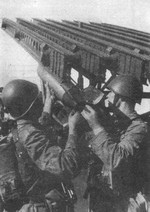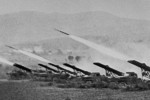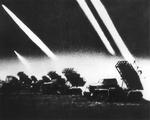BM-13/8/31 Katyusha
| Country | Russia |
| Manufacturer | Voronezh Komintern Factory, Russia |
| Primary Role | Self-Propelled Rocket Artillery |
Contributor: C. Peter Chen
ww2dbaseIn Jun 1938, the Soviet Jet Propulsion Research Institute (RNII) in Leningrad, Russia began developing a multiple rocket launcher, arriving at the BM-13 design in Aug 1939, although the BM-13 name would not be listed in documents until 1942 due to the weapon design's secrecy. These self-propelled rocket launchers were not considered seriously by the Soviet Army, as both the low rate of fire (1 salvo of 24 rockets per 50 minutes) and low accuracy left much to be desired. Between 1940 when the first order was issued and the German invasion in Jun 1941, only 40 examples were built.
ww2dbaseDuring the development and the initial production, these launchers were built at the Voronezh Komintern Factory which had the designation of "K", and the same letter appeared on these secret weapons which the operators did not know the name of. As a result, the troops developed nicknames, many of which were based on the "K" letter. Among the most popular nicknames was Katyusha, after a popular song by Mikhail Isakovsky.
ww2dbaseDespite of what they perceived as shortcomings, when the German invasion began, Soviet officers soon began to see the opportunities afforded by these new weapons after they were used for the first time in combat in Smolensk Oblast, Russia in Jul 1941. Though the firing rate was slow, the launch rails were far cheaper and quicker to construct than the barrels of conventional artillery guns, for that they were essentially a simple rack of parallel rails; each rack held anywhere between 14 to 48 rockets; by the end of 1942, 3,237 Katyusha launchers were built. Their unorthodoxy also had a psychological effect on their targets; because each salvo of rockets produced a symphony of loud howling sounds when firing, some German soldiers would nickname them "Stalin's Organ" ("Stalinorgel"). BM-13 launchers were initially mounted on ZiS-6, ZiS-5, and ZiS5V trucks early in the war, but the demands of war meant that sometimes they were mated to whatever vehicle chassis that the Soviet Army could find; in some instances, the launching racks were mounted on tractors or even tank chassis. Starting in 1942 when the Soviet Union began receiving vehicles built by the Western Allies, many of these vehicles received BM-13 launchers; foreign trucks used to mount BM-13 launchers included those built by International, Studebaker, General Motors, and Ford. The fact that they were built on trucks meant that they could move far to the rear after they had launched their salvos, making it hard for the Germans to locate and destroy them during the long reloading time.
ww2dbaseIn Aug 1941, the smaller BM-8 launchers were approved for production. In addition to being mounted on the typical ZiS-5 and ZiS-6 trucks, some BM-8 launchers were also mated to US-built Willys Jeeps. In 1942, the larger BM-31 launchers were developed to accommodate the new and larger 300-millimeter rockets; they were generally mounted on trucks.
ww2dbaseLess frequently, Katyusha launchers of all three wartime variants were also mounted on railroad cars, river gunboats, and on wheeled trailers for towing.
ww2dbaseAt the end of the war, about 10,000 Katyusha launchers were built.
ww2dbaseAfter the war, BM-13, BM-8, and BM-31 launchers remained in Soviet service and saw combat in Korea and Vietnam. Further development efforts also continued after the war, and many of the later models of BM-series launchers were also nicknamed Katyusha.
ww2dbaseSource: Wikipedia
Last Major Revision: May 2012
BM-13/8/31 Katyusha Timeline
| 14 Jul 1941 | Katyusha rocket launchers were used in combat for the first time at Rudnya, Smolensk, Russia. |
| 8 Aug 1941 | Joseph Stalin ordered the formation of eight Guards mortar regiments directly under the control of the Stavka to operate Katyusha rocket launchers. |
| 6 May 1944 | Soviet troops bombarded Sevastopol, Russia with Katyusha rocket launchers. |
SPECIFICATIONS
BM-8-8 (Willys MB Jeep)
| Machinery | One 4-cylinder gasoline engine rated at 60hp |
| Suspension | Leaf springs |
| Armament | 8x82mm M-8 rockets |
| Length | 3.33 m |
| Width | 1.58 m |
| Weight | 1.0 t |
BM-8-36 (ZiS-5 Truck)
| Machinery | One 6-cylinder gasoline engine rated at 73hp |
| Suspension | Wheels, 4x2 |
| Armament | 48x82mm M-8 rockets |
| Length | 6.06 m |
| Width | 2.24 m |
| Weight | 3.1 t |
| Speed | 60 km/h |
BM-13-16 (GMC CCKW Truck)
| Machinery | One GMC 6-cylinder 269 cubic inch engine rated at 91.5hp |
| Suspension | Wheels, 6x6 |
| Armament | 16x132mm M-13 rockets |
| Length | 6.40 m |
| Width | 2.30 m |
| Weight | 5.2 t |
| Speed | 72 km/h |
| Range | 385 km |
BM-31-12 (Studebaker US6 U3 Truck)
| Machinery | One 6-cylinder gasoline engine rated at 94hp |
| Suspension | Wheels, 6x4 or 6x6 |
| Armament | 12x300mm M-31 rockets |
Photographs
 |  |  |  |
Did you enjoy this article or find this article helpful? If so, please consider supporting us on Patreon. Even $1 per month will go a long way! Thank you. Share this article with your friends: Stay updated with WW2DB: |
Visitor Submitted Comments
14 Jul 2020 01:36:41 PM
The Katyusha was debuted on July 14, 1941 but not at Rudnya, Smolensk but in Orsha, Belarus in the fight for the train station.
All visitor submitted comments are opinions of those making the submissions and do not reflect views of WW2DB.
- » WW2DB's 20th Anniversary (29 Dec 2024)
- » Wreck of USS Edsall Found (14 Nov 2024)
- » Autumn 2024 Fundraiser (7 Nov 2024)
- » Nobel Peace Prize for the Atomic Bomb Survivors Organization (11 Oct 2024)
- » See all news
 |
- » 1,150 biographies
- » 337 events
- » 44,024 timeline entries
- » 1,242 ships
- » 350 aircraft models
- » 207 vehicle models
- » 375 weapon models
- » 123 historical documents
- » 260 facilities
- » 470 book reviews
- » 28,598 photos
- » 432 maps
Joachim von Ribbentrop, German Foreign Minister, Aug 1939
Please consider supporting us on Patreon. Even $1 a month will go a long way. Thank you!
Or, please support us by purchasing some WW2DB merchandise at TeeSpring, Thank you!
30 Aug 2019 08:57:03 AM
The 132mm M-13 Rocket was developed from the RS-132 air launched rocket with a larger motor and warhead. Most warheads were simple 22kg impact-fused HE-fragmentation types, although there is a possibility that HEAT warheads may have been developed for use against tank concentrations. Some Russian reports indicate that illumination and incendiary warheads were also used in small numbers. Just entering service at the time of the German invasion the M-13 had a maximum range of 8,500 metres and, despite being slow to reload and less accurate than conventional artillery, a battery of four launchers could, in 7-10 seconds, fire a salvo that delivered 4.42 tonnes of HE over a four-hectare impact zone. Well trained crews could then redeploy in a matter of a few minutes to avoid counter-battery fire.